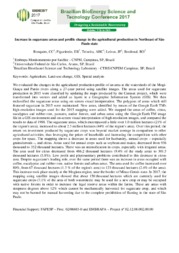Increase in sugarcane areas and profile change in the agricultural production in Northeast of São Paulo state.
Increase in sugarcane areas and profile change in the agricultural production in Northeast of São Paulo state.
Author(s): RONQUIM, C. C.; FIGUEIREDO, E. B.; TEIXEIRA, A. H. de C.; LEIVAS, J. F.; BORDONAL, R. O.
Summary: We evaluated the changes in the agricultural production profile of an area at the watersheds of the Mogi-Guaçu and Pardo rivers along a 27-year period using satellite images. The areas used for sugarcane production in 2015 were classified by updating the maps produced by the Canasat project, which were transformed into vectors and added as layers in a Geographic Information System (GIS). We then reclassified the sugarcane areas using on-screen visual interpretation. The polygons of areas which still featured sugarcane in 2015 were maintained. New areas, identified by means of the Google Earth TM's high-resolution images used for the 2015 mapping were added. We mapped the areas of coffee, citrus, eucalyptus and rubber-tree, pastures, native forests, and urban areas using the Google Earth TM image file in a GIS environment and on-screen visual interpretation of high-resolution images, and compared the results to data of 1988. The sugarcane areas, which encompassed a little over 1.0 million hectares (21% of the region's area), increased to about 2.3 million hectares (44% of the region's area). Over this period, the return on investment produced by sugarcane crops was beyond market average in comparison to other agricultural activities, thus leveraging the prices of leaseholds and increasing the competition with other crops for space. The mapping shows a decrease in areas used for husbandry, annual crops ? especially grains/cereals ?, and citrus. Areas used for annual crops such as soybean and maize, decreased from 936 thousand to 352 thousand hectares. There was an intensification in crops, especially with irrigated areas. The area used for citrus decreased from 486.2 thousand hectares (9.4% of the study area) to 301.5 thousand hectares (5.8%). Low profit and phytosanitary problems contributed to this decrease in citrus area. Despite sugarcane's leading role, over the same period there was an increase in areas occupied with coffee, eucalyptus and rubber-tree, native forests and urban areas. The area used for coffee increased over 80%, from 67 thousand hectares (1.3 % of the region's area) to 123 thousand hectares (2.4% of the area). This increase took place mainly at the Mogiana region, near the border of Minas Gerais state. In 2017, the mapping using satellite images showed that about 150 thousand hectares which are currently used for sugarcane crops (7.1% of the area of both watersheds) may be used for a new crop or may be occupied with native forests in order to increase the legal reserve areas within the farms. These are areas with steepness degrees above 12% which cannot be mechanically harvested for sugarcane crop, and which may not be burned for manual harvesting due to the complete prohibition of flaming in the state of São Paulo.
Publication year: 2017
Types of publication: Abstract in annals or event proceedings
Unit: Embrapa Territorial
Keywords: Agriculture, GIS, Land-use change, Spatial analysis
Observation
Some of Embrapa's publications are published as ePub files. To read them, use or download one of the following free software options to your computer or mobile device. Android: Google Play Books; IOS: iBooks; Windows and Linux: Calibre.
Access other publications
Access the Agricultural Research Database (BDPA) to consult Embrapa's full library collection and records.
Visit Embrapa Bookstore to purchase books and other publications sold by Embrapa.

